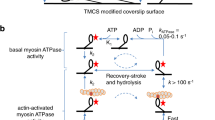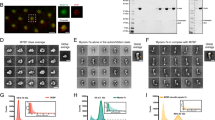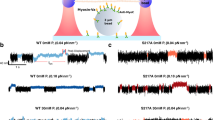Abstract
Myosin Va transports intracellular cargoes along actin filaments in cells1. This processive, two-headed motor takes multiple 36-nm steps in which the two heads swing forward alternately towards the barbed end of actin driven by ATP hydrolysis2. The ability of myosin Va to move processively is a function of its long lever arm, the high duty ratio of its kinetic cycle and the gating of the kinetics between the two heads such that ADP release from the lead head is greatly retarded3,4,5,6,7,8,9,10. Mechanical studies at the multiple- and the single-molecule level suggest that there is tight coupling (that is, one ATP is hydrolysed per power stroke), but this has not been directly demonstrated4,5,11. We therefore investigated the coordination between the ATPase mechanism of the two heads of myosin Va and directly visualized the binding and dissociation of single fluorescently labelled nucleotide molecules, while simultaneously observing the stepping motion of the fluorescently labelled myosin Va as it moved along an actin filament. Here we show that preferential ADP dissociation from the trail head of mouse myosin Va is followed by ATP binding and a synchronous 36-nm step. Even at low ATP concentrations, the myosin Va molecule retained at least one nucleotide (ADP in the lead head position) when moving. Thus, we directly demonstrate tight coupling between myosin Va movement and the binding and dissociation of nucleotide by simultaneously imaging with near nanometre precision.
This is a preview of subscription content, access via your institution
Access options
Subscribe to this journal
Receive 51 print issues and online access
$199.00 per year
only $3.90 per issue
Buy this article
- Purchase on Springer Link
- Instant access to full article PDF
Prices may be subject to local taxes which are calculated during checkout




Similar content being viewed by others
References
Sellers, J. R. & Weisman, L. S. Myosins: A Superfamily of Molecular Motors, Proteins and Cell Regulation Vol. 7 (ed. Coluccio, L) 289–324 (Springer, 2008)
Vale, R. D. Myosin V motor proteins: marching stepwise towards a mechanism. J. Cell Biol. 163, 445–450 (2003)
Sakamoto, T., Yildiz, A., Selvin, P. R. & Sellers, J. R. Step-size is determined by neck length in myosin V. Biochemistry 44, 16203–16210 (2005)
Mehta, A. D. et al. Myosin-V is a processive actin-based motor. Nature 400, 590–593 (1999)
Rief, M. et al. Myosin-V stepping kinetics: a molecular model for processivity. Proc. Natl Acad. Sci. USA 97, 9482–9486 (2000)
De La Cruz, E. M., Wells, A. L., Rosenfeld, S. S., Ostap, E. M. & Sweeney, H. L. The kinetic mechanism of myosin V. Proc. Natl Acad. Sci. USA 96, 13726–13731 (1999)
Rosenfeld, S. S. & Sweeney, H. L. A model of myosin V processivity. J. Biol. Chem. 279, 40110–40111 (2004)
Purcell, T. J., Sweeney, H. L. & Spudich, J. A. A force-dependent state controls the coordination of processive myosin V. Proc. Natl Acad. Sci. USA 102, 13873–13878 (2005)
Veigel, C., Schmitz, S., Wang, F. & Sellers, J. R. Load-dependent kinetics of myosin-V can explain its high processivity. Nature Cell Biol. 7, 861–869 (2005)
Forgacs, E. et al. Kinetics of ADP dissociation from the trail and lead heads of actomyosin V following the power stroke. J. Biol. Chem. 283, 766–773 (2007)
Veigel, C., Wang, F., Bartoo, M. L., Sellers, J. R. & Molloy, J. E. The gated gait of the processive molecular motor, myosin V. Nature Cell Biol. 4, 59–65 (2001)
Funatsu, T., Harada, Y., Tokunaga, M., Saito, K. & Yanagida, T. Imaging of single fluorescent molecules and individual ATP turnovers by single myosin molecules in aqueous solution. Nature 374, 555–559 (1995)
Ishijima, A. et al. Multiple- and single-molecule analysis of the actomyosin motor by nanometer piconewton manipulation with a microneedle: Unitary steps and forces. Biophys. J. 70, 383–400 (1996)
Tokunaga, M., Kitamura, K., Saito, K., Iwane, A. H. & Yanagida, T. Single molecule imaging of fluorophores and enzymatic reactions achieved by objective-type total internal reflection fluorescence microscopy. Biochem. Biophys. Res. Commun. 235, 47–53 (1997)
Oiwa, K. et al. Comparative single-molecule and ensemble myosin enzymology: sulfoindocyanine ATP and ADP derivatives. Biophys. J. 78, 3048–3071 (2000)
Webb, M. R., Reid, G. P., Munasinghe, V. R. & Corrie, J. E. A series of related nucleotide analogues that aids optimization of fluorescence signals in probing the mechanism of P-loop ATPases, such as actomyosin. Biochemistry 43, 14463–14471 (2004)
Forgacs, E. et al. Kinetic mechanism of myosinV-S1 using a new fluorescent ATP analogue. Biochemistry 45, 13035–13045 (2006)
Yildiz, A. et al. Myosin V walks hand-over-hand: single fluorophore imaging with 1.5-nm localization. Science 300, 2061–2065 (2003)
Dunn, A. R. & Spudich, J. A. Dynamics of the unbound head during myosin V processive translocation. Nature Struct. Mol. Biol. 14, 246–248 (2007)
Burgess, S. et al. The prepower stroke conformation of myosin V. J. Cell Biol. 159, 983–991 (2002)
Rosenfeld, S. S., Houdusse, A. & Sweeney, H. L. Magnesium regulates ADP dissociation from myosin V. J. Biol. Chem. 280, 6072–6079 (2005)
Sakamoto, T. et al. Neck length and processivity of myosin V. J. Biol. Chem. 278, 29201–29207 (2003)
Thirumurugan, K., Sakamoto, T., Hammer, J. A., Sellers, J. R. & Knight, P. J. The cargo-binding domain regulates structure and activity of myosin 5. Nature 442, 212–215 (2006)
Wang, F. et al. Effect of ADP and ionic strength on the kinetic and motile properties of recombinant mouse myosin V. J. Biol. Chem. 275, 4329–4335 (2000)
Webb, M. R. & Corrie, J. E. Fluorescent coumarin-labeled nucleotides to measure ADP release from actomyosin. Biophys. J. 81, 1562–1569 (2001)
Sakamoto, T., Amitani, I., Yokota, E. & Ando, T. Direct observation of processive movement by individual myosin V molecules. Biochem. Biophys. Res. Commun. 272, 586–590 (2000)
Thompson, R. E., Larson, D. R. & Webb, W. W. Precise nanometer localization analysis for individual fluorescent probes. Biophys. J. 82, 2775–2783 (2002)
Acknowledgements
We thank F. Zhang, A. Smith and G. Reid for technical assistance; E. Yokoi for the TIRF illuminator to combine two optical cables; C. Fanghella for technical help in the calculation of the number of photons; and C. Weaver for help with Metamorph. We are appreciative of the critical comments on the manuscript made by P. J. Knight and E. Homsher. M.R.W. was supported by the Medical Research Council, UK. J.R.S. and T.S. were supported by the National Heart, Lung and Blood Intramural Program. H.D.W. and E.F. were supported by NIH EB00209 and a postdoctoral fellowship from the American Heart Association.
Author Contributions Single molecule motility experiments and data analysis were performed by T.S. and kinetic experiments data by E.F. Deac-aminoATP/ADP were provided by M.R.W. T.S., J.R.S. and H.D.W. participated in the conception of the experiment. T.S. wrote the first draft of the manuscript and all authors participated in producing the final version. All authors participated in discussion and interpretation of the data.
Author information
Authors and Affiliations
Corresponding author
Supplementary information
Supplementary Information 1
The file contains Supplementary Figures 1-9 with Legends. (PDF 1104 kb)
nature07188-s2.avi
The file contains Supplementary Movie 1. (AVI 110 kb)
Rights and permissions
About this article
Cite this article
Sakamoto, T., Webb, M., Forgacs, E. et al. Direct observation of the mechanochemical coupling in myosin Va during processive movement. Nature 455, 128–132 (2008). https://doi.org/10.1038/nature07188
Received:
Accepted:
Published:
Issue Date:
DOI: https://doi.org/10.1038/nature07188
This article is cited by
-
Modulating mechanical stability of heterodimerization between engineered orthogonal helical domains
Nature Communications (2020)
-
Studies on the impellers generating force in muscle
Biophysical Reviews (2020)
-
A model for the chemomechanical coupling of the mammalian cytoplasmic dynein molecular motor
European Biophysics Journal (2019)
-
Dissecting myosin-5B mechanosensitivity and calcium regulation at the single molecule level
Nature Communications (2018)
Comments
By submitting a comment you agree to abide by our Terms and Community Guidelines. If you find something abusive or that does not comply with our terms or guidelines please flag it as inappropriate.



